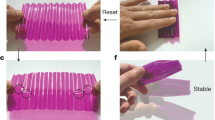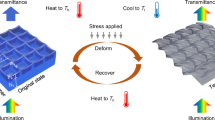Abstract
Security inks have become of increasing importance1,2. They are composed of invisible substances that provide printed images that are not able to be photocopied, and are readable only under special environments. Here we report a novel photoluminescent ink for rewritable media that dichroically emits phosphorescence due to a structural bistability of the self-assembled luminophor. Long-lasting images have been developed by using conventional thermal printers, which are readable only on exposure to ultraviolet light, and more importantly, are thermally erasable for rewriting. Although thermally rewritable printing media have already been developed using visible dyes3,4,5 and cholesteric liquid crystals6,7, security inks that allow rewriting of invisible printed images are unprecedented. We realized this unique feature by the control of kinetic and thermodynamic processes that compete with one another in the self-assembly of the luminophor. This strategy can provide an important step towards the next-generation security technology for information handling.
This is a preview of subscription content, access via your institution
Access options
Subscribe to this journal
Receive 12 print issues and online access
$259.00 per year
only $21.58 per issue
Buy this article
- Purchase on Springer Link
- Instant access to full article PDF
Prices may be subject to local taxes which are calculated during checkout



Similar content being viewed by others
References
Yousaf, M. & Lazzouni, M. Formulation of an invisible infrared printing ink. Dyes Pigments 27, 297–303 (1995).
Phillips, R. W. & Bleikolm, A. F. Optical coatings for document security. Appl. Opt. 35, 5529–5534 (1996).
Tsutsui, K., Yamaguchi, T. & Sato, K. Thermochromic properties of mixture systems of octadecylphosphonic acid and fluoran dye. Jpn J. Appl. Phys. 33, 5925–5928 (1994).
Naito, K. Amorphous–crystal transition of organic dye assemblies: application to rewritable colour recording media. Appl. Phys. Lett. 67, 211–213 (1995).
MacLaren, D. C. & White, M. A. Dye–developer interactions in the crystal violet lactone–lauryl gallate binary system: implications for thermochromism. J. Mater. Chem. 13, 1695–1700 (2003).
Tamaoki, N., Parfenov, A. V., Masaki, A. & Matsuda, H. Rewritable full-colour recording on a thin solid film of a cholesteric low-molecular-weight compound. Adv. Mater. 9, 1102–1104 (1997).
Tamaoki, N. Cholesteric liquid crystals for color information technology. Adv. Mater. 13, 1135–1147 (2001).
Yam, V. W. -W. & Lo, K. K. -W. in Molecular and Supramolecular Photochemistry Vol. 4; Multimetallic and Macromolecular Inorganic Photochemistry (eds Ramamurthy, V. & Schanze, K. S.) Ch. 2, 31–112 (Marcel Dekker, New York, 1999).
Ford, P. C., Cariati, E. & Bourassa, J. Photoluminescence properties of multinuclear copper(I) compounds. Chem. Rev. 99, 3625–3647 (1999).
Enomoto, M., Kishimura, A. & Aida, T. Coordination metallacycles of an achiral dendron self-assemble via metal-metal interaction to form luminescent superhelical fibers. J. Am. Chem. Soc. 123, 5608–5609 (2001).
Kishimura, A., Yamashita, T. & Aida, T. Phosphorescent organogels via 'metallophilic' interactions for reversible RGB–colour switching. J. Am. Chem. Soc. 127, 179–183 (2005).
Carvajal, M. A., Alvarez, S. & Novoa, J. J. The nature of intermolecular CuI···CuI interactions: A combined theoretical and structural database analysis. Chem. Eur. J. 10, 2117–2132 (2004).
Pyykkö, P., Runeberg, N. & Mendizabal, F. Theory of the d10–d10 closed–shell attraction: 1. Dimers near equilibrium. Chem. Eur. J. 3, 1451–1457 (1997).
Kim, S. J. et al. Trinuclear gold(I) pyrazolate complexes exhibiting hexagonal columnar mesophases with only three side chains. Chem. Mater. 10, 1889–1893 (1998).
Barberá, J. et al. (Pyrazolato)gold complexes showing room–temperature columnar mesophases. Synthesis, properties, and structural characterization. Inorg. Chem. 37, 2960–2967 (1998).
Kubas, G. J. Tetarakis(acetonitrile)copper(1+)hexafluorophosphate(1−). Inorg. Synth. 28, 68–70 (1990).
Acknowledgements
We thank S. Harada (Ricoh Co) for fabrication of phosphorescent papers; T. Kato (The University of Tokyo) for DSC measurements. A. K. acknowledges the JSPS Young Scientist Fellowship.
Author information
Authors and Affiliations
Corresponding author
Ethics declarations
Competing interests
The authors declare no competing financial interests.
Supplementary information
Supplementary Information
Supplementary information and figures (PDF 1175 kb)
Rights and permissions
About this article
Cite this article
Kishimura, A., Yamashita, T., Yamaguchi, K. et al. Rewritable phosphorescent paper by the control of competing kinetic and thermodynamic self-assembling events. Nature Mater 4, 546–549 (2005). https://doi.org/10.1038/nmat1401
Received:
Accepted:
Published:
Issue Date:
DOI: https://doi.org/10.1038/nmat1401
This article is cited by
-
Photo-thermo-induced room-temperature phosphorescence through solid-state molecular motion
Nature Communications (2022)
-
Oriented assembly of metal-organic frameworks and deficient TiO2 nanowires directed by lattice matching for efficient photoreversible color switching
Science China Materials (2022)
-
Tuning molecular emission of organic emitters from fluorescence to phosphorescence through push-pull electronic effects
Nature Communications (2020)
-
Miracles of molecular uniting
Science China Materials (2020)
-
Organic polymers achieving smart room-temperature phosphorescence
Science China Chemistry (2019)



